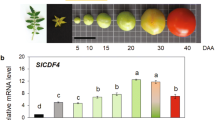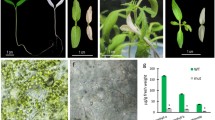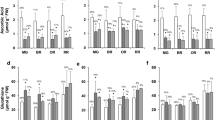Abstract
Main conclusion
Reduced GDP-l-galactose phosphorylase expression and deficiency of ascorbic acid content lead to decreased fruit set and yield in tomato plants.
Abstract
Reduced GDP-l-galactose phosphorylase expression and deficiency of ascorbic acid content lead to decreased fruit set and yield in tomato plants. GDP-l-galactose phosphorylase (GGP) catalyzes the first step committed to ascorbic acid synthesis. The participation of GDP-l-galactose phosphorylase and ascorbate in tomato fruit production and quality was studied in this work using two SlGGP1 deficient EMS Micro-Tom mutants. The SlGGP1 mutants display decreased concentrations of ascorbate in roots, leaves, flowers, and fruit. The initiation of anthesis is delayed in ggp1 plants but the number of flowers is similar to wild type. The number of fruits is reduced in ggp1 mutants with an increased individual weight. However, the whole fruit biomass accumulation is reduced in both mutant lines. Fruits of the ggp1 plants produce more ethylene and show higher firmness and soluble solids content than the wild type after the breaker stage. Leaf CO2 uptake decreases about 50% in both ggp1 mutants at saturating light conditions; however, O2 production in an enriched CO2 atmosphere is only 19% higher in wild type leaves. Leaf conductance that is largely reduced in both mutants may be the main limitation for photosynthesis. Sink-source assays and hormone concentration were measured to determine restrictions to fruit yield. Manipulation of leaf area/fruit number relationship demonstrates that the number of fruits and not the provision of photoassimilates from the source restricts biomass accumulation in the ggp1 lines. The lower gibberellins concentration measured in the flowers would contribute to the lower fruit set, thus impacting in tomato yield. Taken as a whole these results demonstrate that ascorbate biosynthetic pathway critically participates in tomato development and fruit production.




taken from ggp1 mutants and wild type plants grown under greenhouse conditions at green mature, breaker and red stages. The values were obtained from at least three independent experiments and expressed as the means ± SD (ANOVA P < 0.05). Lower and upper case letters indicate statistical differences between genotypes and stages, respectively

Similar content being viewed by others
References
Alhagdow M, Mounet F, Gilbert L, Nunes-Nesi A, Garcia V, Just D, Petit J, Beauvoit B, Fernie AR, Rothan C, Baldet P (2007) Silencing of the mitochondrial ascorbate synthesizing enzyme L-galactono-1,4-lactone dehydrogenase affects plant and fruit development in tomato. Plant Physiol 145:1408–1422
Asada K (1999) The water-water cycle in chloroplasts: Scavenging of active oxygens and dissipation of excess photons. Annu Rev Plant Phys 50:601–639
Baker NR (2008) Chlorophyll fluorescence: a probe for photosynthesis in vivo. Annu Rev Plant Biol 59:89–113
Baldet P, Bres C, Okabe Y, Mauxion JP, Just D, Bournonville C, Ferrand C, Mori K, Ezure H, Rothan C (2013) Investigating the role of vitamin C in tomato through TILLING identification of ascorbate-deficient tomato mutants. Plant Biotechnol 30:308–314
Barth C, De Tullio M, Conklin PL (2006) The role of ascorbic acid in the control of flowering time and the onset of senescence. J Exp Bot 57:1657–1665
Barth C, Gouzd ZA, Steele HP, Imperio RM (2010) A mutation in GDP-mannose pyrophosphorylase causes condition hypersensitivity to ammonium, resulting in Arabidopsis root growth inhibition, altered metabolism, and hormone homeostasis. J Exp Bot 61:379–394
Bartoli CG, Simontachi M, Montaldi E, Puntarulo S (1996) Oxidative stress, antioxidant capacity and ethylene production during ageing of cut carnation (Dianthus caryophyllus) petals. J Exp Bot 47:595–601
Bartoli CG, Yu J, Gómez F, Fernández L, McIntosh L, Foyer CH (2006) Inter-relationships between light and respiration in the control of ascorbic acid synthesis and accumulation in Arabidopsis thaliana leaves. J Exp Bot 57:1621–1631
Caviglia M, Mazorra Morales LM, Concellón A, Gergoff Grozeff GE, Wilson M, Foyer CH, Bartoli CG (2018) Ethylene signaling triggered by low concentrations of ascorbic acid regulates biomass accumulation in Arabidopsis thaliana. Free Radic Bio Med 122:130–136
Dowdle J, Ishikawa T, Gatzek S, Rolinski S, Smirnoff N (2007) Two genes in Arabidopsis thaliana encoding GDP-L-galactose phosphorylase are required for ascorbate biosynthesis and seedling viability. Plant J 52:673–689
Foyer CH, Noctor CH (2011) Ascorbate and glutathione: The heart of the redox hub. Plant Physiol 155:2–18
Gao Y, Badejo AA, Shibata H, Sawa Y, Maruta T, Shigeoka S, Page M, Smirnoff N, Ishikawa T (2011) Expression analysis of the VTC2 and VTC5 genes encoding GDP-l-Galactose Phosphorylase, an enzyme involved in ascorbate biosynthesis, in Arabidopsis thaliana. Biosci Biotechnol Biochem 75:1783–1788
Genty B, Briantais JM, Baker NR (1989) The relationship between the quantum yield of photosynthetic electron transport and quenching of chlorophyll fluorescence. Biochim Biophys Acta 990:87–92
Gergoff Grozeff GE, Senn ME, Alegre M, Chaves AR, Bartoli CG (2016) Nocturnal low irradiance pulses improve fruit yield and lycopene concentration in tomato. Sci Hortic 203:47–52
Gilbert L, Alhagdow M, Nunes-Nesi A, Quemener B, Guillon F, Bouchet B, Faurobert M, Gouble B, Page D, Garcia V, Petit J, Stevens R, Causse M, Fernie AR, Lahaye M, Rothan C, Baldet P (2009) GDP-D-mannose epimerase (GME) plays a key role at the intersection of ascorbate and non cellulosic cell wall biosynthesis in tomato. Plant J 60:499–508
Gilbert L, Dumont M, Ferrand C, Bournonville C, Monier A, Jorly J, Lemaire-Chamley M, Mori K, Atienza I, Hernould M, Stevens R, Lehner A, Mollet JC, Rothan C, Lerouge P, Baldet P (2016) Two tomato GDP-D-mannose epimerase isoforms involved in ascorbate biosynthesis play specifc roles in cell wall biosynthesis and development. J Exp Bot 67:4767–4777
Kotchoni SO, Larrimore KE, Mukherjee M, Kempinski CF, Barth C (2009) Alterations in the endogenous ascorbic acid content affect flowering time in Arabidopsis. Plant Physiol 149:803–815
Laing WA, Wright MA, Cooney J, Bulley SM (2007) The missing step of the L-galactose pathway of ascorbate biosynthesis in plants, an L-galactose guanyltransferase, increases leaf ascorbate content. P Natl Acad Sci USA 104:9534–9539
Laing WA, Martinez-Sanchez M, Wright MA, Bulley SM, Brewster D, Dare AP, Rassam M, Wang D, Storey R, Macknight RC, Hellens RP (2015) An upstream open reading frame is essential for feedback regulation of ascorbate biosynthesis in arabidopsis. Plant Cell 27:772–786
Lee SK, Kader AA (2000) Preharvest and postharvest factors influencing vitamin C content of horticultural crops. Postharvest Biol Tech 20:207–220
Li T, Yang X, Yu Y, Si X, Zhai X, Zhang H, Dong W, Gao C, Xu C (2018) Domestication of wild tomato is accelerated by genome editing. Nat Biotechnol 36:1160–1163
Lim B, Smirnoff N, Cobbett CS, Golz JF (2016) Ascorbate-deficient vtc2 mutants in Arabidopsis do not exhibit decreased growth. Front Plant Sci 7:1025–1030
Linster C, Gomez TA, Christensen KC, Adler LN, Young BD, Brenner C, Clarke SG (2007) Arabidopsis VTC2 encodes a GDP-L-galactose phosphorylase, the last unknown enzyme in the Smirnoff-Wheeler pathway o ascorbic acid in plants. J Biol Chem 282:18879–18885
Macknight RC, Laing WA, Bulley SM, Broad RC, Johnson AAT, Hellens RP (2017) Increasing ascorbate levels in crops to enhance human nutrition and plant abiotic stress tolerance. Curr Opin Biotech 44:153–160
Masciarelli O, Llanes A, Luna V (2014) A new PGPR co-inoculated with Bradyrhizobium japonicum enhances soybean nodulation. Microbiol Res 169:609–615
Massot C, Stevens R, Génard M, Longuenesse JJ, Gautier H (2012) Light affects ascorbate content and ascorbate-related gene expression in tomato leaves more than in fruits. Planta 235:153–163
Müller-Moulé P, Conklin PL, Niyogi KK (2002) Ascorbate deficiency can limit violaxanthin de-epoxidase activity in vivo. Plant Physiol 128:970–977
Osorio S, Alba R, Damasceno CMB, Lopez-Casado G, Lohse M, Zanor MI, Tohge T, Usadel B, Rose JKC, Fei Z, Giovannoni JJ, Fernie AR (2011) Systems biology of tomato fruit development: Combined transcript, protein, and metabolite analysis of tomato transcription factor (nor, rin) and ethylene receptor (Nr) mutants reveals novel regulatory interactions. Plant Physiol 157:405–425
Pavet V, Olmos E, Kiddle G, Mowla S, Kumar S, Antoniw J, Alvarez ME, Foyer CH (2005) Ascorbic acid deficiency activates cell death and disease resistance responses in arabidopsis. Plant Physiol 139:1291–1303
Plumb W, Townsend AJ, Rasool B, Alomrani S, Razak N, Karpinska B, Ruban AV, Foyer CH (2018) Ascorbate-mediated regulation of growth, photoprotection, and photoinhibition in Arabidopsis thaliana. J Exp Bot 69:2823–2835
Ruan Y-L, Patrick JW, Bouzayen M, Osorio S, Fernie AR (2012) Molecular regulation of seed and fruit set. Trends Plant Sci 17:656–665
Saladié M, Matas AJ, Isaacson T, Jenks MA, Goodwin SM, Niklas KJ, Xiaolin R, Labavitch JM, Shackel KA, Fernie AR, Lytovchenko A, O’Neill MA, Watkins CB, Rose JKC (2007) A reevaluation of the key factors that influence tomato fruit softening and integrity. Plant Physiol 144:1012–1028
Senn ME, Gergoff Grozeff GE, Alegre ML, Barrile F, De Tullio MC, Bartoli CG (2016) Effect of mitochondrial ascorbic acid synthesis on photosynthesis. Plant Physiol Biochem 104:29–35
Serrani JC, Sanjuán R, Ruiz-Rivero O, Fos M, García-Martínez JL (2007) Gibberellin regulation of fruit set and growth in tomato. Plant Physiol 145:246–257
Shinozaki Y, Hao S, Kojima M, Sakakibara H, Ozeki-Iida Y, Zheng Y, Fei Z, Zhong S, Giovannoni JJ, Rose JKC, Okabe Y, Heta Y, Ezura H, Ariizumi T (2015) Ethylene suppresses tomato (Solanum lycopersicum) fruit set through modification of gibberellin metabolism. Plant J 83:237–251
Smirnoff N (2018) Ascorbic acid metabolism and functions: A comparison of plants and mammals. Free Radic Bio Med 122:116–129
Tanaka A, Fujita K (1974) Nutrio-physiological studies on the tomato plant IV. Source-sink relationship and structure of the source-sink unit. Soil Sci Plant Nutr 20:305–315
Walker D (1987) The use of the oxygen electrode and fluorescence probes in simple measurements of photosynthesis. Oxygraphics Limited, University of Sheffield Print Unit, Sheffield, UK, p 203
Wang L-Y, Li D, Deng Y-S, Lv W, Meng Q-W (2013) Antisense-mediated depletion of tomato GDP-L-galactosephophorylase increases susceptibility to chilling stress. J Plant Physiol 170:303–314
Yang D-Y, Li M, Ma N-N, Yang X-H, Meng Q-W (2017) Tomato SlGGP-LIKE gene participates in plant responses to chilling stress and pathogenic infection. Plant Physiol Biochem 112:218–226
Yoshimura K, Nakane T, Kume S, Shiomi Y, Maruta T, Ishikawa T, Shigeoka S (2014) Transient expression analysis revealed the importance of VTC2 expression level in light/dark regulation of ascorbate biosynthesis in Arabidopsis. Biosci Biotech Bioch 78:60–66
Zhang C, Ouyang B, Yang C, Zhang X, Liu H, ZhangY ZJ, Li H, Ye Z (2013) Reducing AsA leads to leaf lesion and defence response in knock-down of the AsA biosynthetic enzyme GDP-D-Mannose pyrophosphorylase gene in tomato plant. PLoS ONE 8(4):e61987
Acknowledgements
We are really grateful to Dr Eduardo Tambussi for his valuable discussion of the results, Dr Gabriela Cano for her technical assistance and Dr Diego Fanello for the statistical analysis. GEGG and CGB are researchers at the Consejo Nacional de Investigaciones Científicas y Técnicas (CONICET, Argentina). MA and CS are fellows at CONICET and Agencia Nacional de Promoción Científica y Técnica (ANPCyT, Argentina), respectively. This work was supported by grants PICT 2015–0103 (ANPCyT) and A258 and A322 (Universidad Nacional de La Plata, Argentina).
Author information
Authors and Affiliations
Corresponding author
Additional information
Publisher's Note
Springer Nature remains neutral with regard to jurisdictional claims in published maps and institutional affiliations.
Electronic supplementary material
Below is the link to the electronic supplementary material.
Rights and permissions
About this article
Cite this article
Alegre, M.L., Steelheart, C., Baldet, P. et al. Deficiency of GDP-l-galactose phosphorylase, an enzyme required for ascorbic acid synthesis, reduces tomato fruit yield. Planta 251, 54 (2020). https://doi.org/10.1007/s00425-020-03345-x
Received:
Accepted:
Published:
DOI: https://doi.org/10.1007/s00425-020-03345-x




